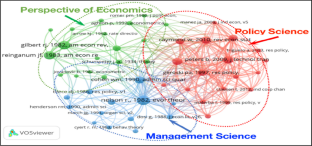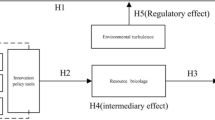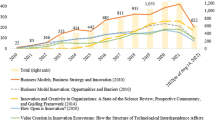Abstract
In today’s rapidly evolving global economy, enterprise persistent innovation is the key to the success of the enterprise, and the inexhaustible power of development can help enterprises in the fierce business competition to obtain competitive advantages and continue to maintain the leading position. This study through the WOS database of SSCI, SCI-E journal library of 1062 English literature review and scientific knowledge map analysis, thus defined the connotation of enterprise persistent innovation and measurement, exploration, and the enterprise persistent innovation research knowledge base and research hotspot and reveals the development of enterprise persistent innovation research. On this basis, the integrated analysis framework of the formation mechanism and effect of enterprise persistent innovation is constructed. The study found that the enterprise persistent innovation is a dynamic and lasting process and ability, involving the accumulation, destruction, and reorganization of innovation, which can be measured from the two aspects of innovation results and process. The knowledge base of enterprise persistent innovation involves fields such as economics, management science, and policy science, and research trends have gone through three stages of development. Factors affecting enterprise persistent innovation include technology, organization, individual, and environment. The integration of enterprise capabilities and resources is an important intermediary in the process of persistent innovation and enterprise strategic management, and the external environment plays a regulatory role in the process of persistent innovation. Enterprise persistent innovation also has a positive impact on economic performance and social development. Finally, this study summarizes the shortcomings of existing studies and presents future research perspectives. This paper serves as a valuable resource for researchers, policymakers, and practitioners seeking to navigate the complex terrain of enterprise persistent innovation in an ever-changing business landscape.




Similar content being viewed by others
Data Availability
The datasets used and/or analyzed during the current study are available from the corresponding author on reasonable request.
References
Acemoglu, D., Akcigit, U., Alp, H., et al. (2018). Innovation, reallocation, and growth. American Economic Review, 108(11), 3450–3491.
Achterkamp, M. C., & Vos, J. F. J. (2006). A framework for making sense of sustainable innovation through stakeholder involvement. International Journal of Environmental Technology and Management, 6(6), 525–538.
Aghion, P., & Howitt, P. (1990). A model of growth through creative destruction. NBER.
Anderson, N., Potočnik, K., & Zhou, J. (2014). Innovation and creativity in organizations: A state-of-the-science review, prospective commentary, and guiding framework. Journal of Management, 40(5), 1297–1333.
Angela, T., David, C., & Maria, C. C. (2014). Measuring the persistence in innovation in Spanish manufacturing firms: Empirical evidence using discrete-time duration models. Economics of Innovation and New Technology, 23(5-6), 447–468.
Arnold, M. (2017). Fostering sustainability by linking co-creation and relationship management concepts. Journal of Cleaner Production, 140(Part 1), 179–188.
Arrow, K. J. (1972). Economic welfare and the allocation of resources for invention. Macmillan Education UK.
Bas, C. L., Mothe, C., & Nguyen-Thi, T. U. (2011). Technological innovation persistence: Literature survey and exploration of the role of organizational innovation. Working Papers. https://doi.org/10.2139/ssrn.1969293(7600945)https://ideas.repec.org/p/hal/wpaper/halshs-00649095.html
Batra, S., Sharma, S., Dixit, M. R., & Vohra, N. (2018). Does strategic planning determine innovation in organizations? A study of Indian SME sector. Australian Journal of Management, 43(3), 493–513.
Bianchini, S., & Pellegrino, G. (2019). Innovation persistence and employment dynamics. Research Policy, 48(5), 1171–1186.
Carrillo-Hermosilla, J., Del Río, P., & Könnölä, T. (2010). Diversity of eco-innovations: Reflections from selected case studies. Journal of Cleaner Production, 18(10-11), 1073–1083.
Cefis, E. (2003). Is there persistence in innovative activities? International Journal of Industrial Organization, 21(4), 489–515.
Cefis, E., & Orsenigo, L. (2001). The persistence of innovative activities: A cross-countries and cross-sectors comparative analysis. Research Policy, 30(7), 1139–1158.
Chen, X., & Yang, L. (1999). Ten years of technological innovation. Science Press.
Chen, Y., & Zhao, S. (2008). Analysis of the influence of organizational structure on the persistent innovation ability of small and medium-sized high-tech enterprises. Journal of Guangxi University for Nationalities (Philosophy and Social Sciences Edition), S1, 42–46.
Cho, Y. S., & Linderman, K. (2020). Resource-based product and process innovation model: Theory development and empirical validation. Sustainability, 12(3), 913.
Chowhan, J., Pries, F., & Mann, S. (2017). Persistent innovation and the role of human resource management practices, work organization, and strategy. Journal of Management & Organization, 23(3), 456–471.
Clausen, T., Pohjola, M., Sapprasert, K., et al. (2012). Innovation strategies as a source of persistent innovation. Industrial and Corporate Change, 21(3), 553–585.
Coad, A., & Rao, R. (2008). Innovation and firm growth in high-tech sectors: A quantile regression approach. Research Policy, 37(4), 633–648.
Cohen, W. M., & Levinthal, D. A. (1990). Absorptive capacity: A new perspective on learning and innovation (pp. 128–152). Administrative Science Quarterly.
Crespi, F., & Scellato, G. (2014). Knowledge cumulability and path dependence in innovation persistence. In The Routledge Handbook of the Economics of Knowledge (pp. 116–134). Routledge.
D’Angelo, A., & Baroncelli, A. (2020). An investigation over inbound open innovation in SMEs: Insights from an Italian manufacturing sample. Technology Analysis & Strategic Management, 32(5), 542–560.
De Jesus, A., Antunes, P., Santos, R., & Mendonça, S. (2019). Eco-innovation pathways to a circular economy: Envisioning priorities through a Delphi approach. Journal of Cleaner Production, 228, 1494–1513.
Diana, S. (2014). Persistence of innovation in unstable environments: Continuity and change in the firm’s innovative behavior. Research Policy, 43(4), 726–736.
Diéguez-Soto, J., Duréndez, A., García-Pérez-de-Lema, D., et al. (2016). Technological, management, and persistent innovation in small and medium family firms: The influence of professionalism. Canadian Journal of Administrative Sciences/Revue Canadienne des Sciences de l'Administration, 33(4), 332–346.
Duflos, G. (2006). Persistence of innovation, technological change and quality-adjusted patents in the US pharmaceutical industry. Cahiers de la Maison des Sciences Economiques.
Duysters, G. M., & Hagedoorn, J. (2002). The effect of mergers and acquisitions on the technological performance of companies in a high-tech environment. Technology Analysis & Strategic Management, 14, 67–84.
Ellwood, P., Grimshaw, P., & Pandza, K. (2017). Accelerating the innovation process: A systematic review and realist synthesis of the research literature. International Journal of Management Reviews, 19(4), 510–530.
Fang, S. R., Fang, S. C., Chou, C. H., Yang, S. M., & Tsai, F. S. (2011). Relationship learning and innovation: The role of relationship-specific memory. Industrial Marketing Management, 40(5), 743–753.
Fontana, R., & Vezzulli, A. (2016). Technological leadership and persistence in product innovation in the Local Area Network industry 1990–1999. Research Policy, 45(8), 1604–1619.
Geissdoerfer, M., Vladimirova, D., & Evans, S. (2018). Sustainable business model innovation: A review. Journal of Cleaner Production, 198, 401–416.
Geroski, P. A., Van Reenen, J., & Walters, C. F. (1997). How persistently do firms innovate? Research Policy, 26(1), 33–48.
Gilbert, R. J., & Newbery, D. M. G. (1982). Preemptive patenting and the persistence of monopoly. The American Economic Review, 514–526.
Granstrand, O., & Holgersson, M. (2020). Innovation ecosystems: A conceptual review and a new definition. Technovation, 90, 102098.
Guarascio, D., & Tamagni, F. (2019). Persistence of innovation and patterns of firm growth. Research Policy, 48(6), 1493–1512.
Guo, Z., Peng, Y., & Chen, Y. (2022). How digital finance affects the continuous technological innovation of Chinese energy companies? Frontiers in Energy Research, 10, 833436.
Haned, N., Mothe, C., & Nguyen-Thi, T. U. (2014). Firm persistence in technological innovation: the relevance of organizational innovation. Economics of Innovation and New Technology, 23(5–6), 490–516.
He, Y., & Zhang, S. (2017). Research on the impact of technological innovation sustainability on enterprise performance. Scientific Research Management, 38(09), 1–11.
Holl, A., Peters, B., & Rammer, C. (2022). Local knowledge spillovers and innovation persistence of firms. Economics of Innovation and New Technology, 32(6), 826–850.
Ishak, W. (2017). Creating an innovation culture (Vol. 4). McKinsey Quarterly.
Jang, S. L., Tsai, Y. T., & Chen, J. (2008). Persistent innovation: A cross-country study of output and diversity over time. Applied Economics Letters, 15(4), 323–326.
Järventie-Thesleff, R., Moisander, J., & Villi, M. (2014). The strategic challenge of continuous change in multi-platform media organizations—A strategy-as-practice perspective. International Journal on Media Management, 16(3-4), 123–138.
Kannan-Narasimhan, R. (2014). Organizational ingenuity in nascent innovations: Gaining resources and legitimacy through unconventional actions. Organization Studies, 35(4), 483–509.
Kuang, J., & Cheng, Q. (2010). Entrepreneurship and sustainable enterprise development. Exploration of Economic Issues, 10, 80–85.
Lahti, A. (2021). Economist (2108): Competition theory—The forgotten theory of incomplete competition. Management, 9(2), 71–103.
Laszlo, C., & Zhexembayeva, N. (2017). Embedded sustainability: The next big competitive advantage. Routledge.
Latan, H., Jabbour, C. J. C., de Sousa Jabbour, A. B. L., de Camargo Fiorini, P., & Foropon, C. (2020). Innovative efforts of ISO 9001-certified manufacturing firms: Evidence of links between determinants of innovation, continuous innovation and firm performance. International Journal of Production Economics, 223, 107526.
Le Bas, C., Mothe, C., & Nguyen Thi, T. U. (2011). Technological innovation persistence: Literature survey and exploration of the role of organizational innovation. https://doi.org/10.2139/ssrn.1969293
Le Bas, C., & Scellato, G. (2014). Firm innovation persistence: A fresh look at the frameworks of analysis. Economics of Innovation and New Technology, 23(5-6), 423–446.
Lee, Y. N. (2015). Evaluating and extending innovation indicators for innovation policy. Research Evaluation, 24(4), 471–488.
Lhuillery, S. (2014). Marketing and persistent innovation success. Economics of Innovation and New Technology, 23(5-6), 517–543.
Liang, F., Qiu, Y.X., Li, Q. (2023). How platform leadership promotes the improvement of organizations' continuous innovation capabilities in a dual environment - the mediating role of organizational resilience. Scientific and technological progress and countermeasures (15), 23–31.
Liang, F., Yuanxin, Q., & Qi, L. (2023). How platform leadership promotes the improvement of organizations’ continuous innovation capabilities in a dual environment - The mediating role of organizational resilience. Scientific and Technological Progress and Countermeasures, 15, 23–31.
Lichtenthaler, U., & Lichtenthaler, E. (2009). A capability-based framework for open innovation: Complementing absorptive capacity. Journal of Management Studies, 46(8), 1315–1338.
Long, T. Q. (2021). Is innovation activity persistent among small firms in developing countries? Evidence from Vietnam. Journal of the Asia Pacific Economy, 26(1), 140–157.
Lǚ, C., Peng, C., Li, R., & Yin, J. (2021). The impact of organizational dual learning and its complementarity on enterprise sustainable development performance in a dynamic environment: The intermediary role of persistent innovation ability. Science and Technology Management Research, 41(22), 135–144.
Malerba, F., & Orsenigo, L. (1999). Technological entry, exit and survival: An empirical analysis of patent data. Research Policy, 28(6), 643–660.
Martínez‐Ros, E., & Labeaga, J. M. (2009). Product and process innovation: Persistence and complementarities. European Management Review, 6(1), 64–75.
Martini, A., Laugen, B. T., Gastaldi, L., et al. (2013). Persistent innovation: Towards a paradoxical, ambidextrous combination of exploration and exploitation. International Journal of Technology Management, 61(1), 1–22.
Ndungu, J. M. (2013). Competitive strategies adopted by KENATCO Taxis Limited to achieve competitive advantage. [Doctoral dissertation]. University of Nairobi Library.
Nelson, R. R. (1985). An evolutionary theory of economic change. Harvard University Press.
Pan, Z., Dai, X., & Li, J. (2017). Political gene, marketization process and the sustainability of enterprise innovation. Journal of Guangdong University of Finance and Economics, 32(04), 24–31 + 57.
Peters, B. (2009). Persistence of innovation: Stylised facts and panel data evidence. The Journal of Technology Transfer, 34, 226–243.
Ponta, L., Puliga, G., & Manzini, R. (2021). A measure of innovation performance: The Innovation Patent Index. Management Decision, 59(13), 73–98.
Rauter, R., Globocnik, D., Perl-Vorbach, E., et al. (2019). Open innovation and its effects on economic and sustainability innovation performance. Journal of Innovation & Knowledge, 4(4), 226–233.
Raymond, W., Mohnen, P., Palm, F., et al. (2010). Persistence of innovation in Dutch manufacturing: Is it spurious? The Review of Economics and Statistics, 92(3), 495–504.
Reinganum, J. F. (1983). Technology adoption under imperfect information. The Bell Journal of Economics, 57–69.
Russell, M. G., & Smorodinskaya, N. V. (2018). Leveraging complexity for ecosystemic innovation. Technological Forecasting and Social Change, 136, 114–131.
Ruttan, V. W. (1997). Induced innovation, evolutionary theory and path dependence: Sources of technical change. The Economic Journal, 107(444), 1520–1529.
Salomo, S., Weise, J., & Gemünden, H. G. (2007). NPD planning activities and innovation performance: The mediating role of process management and the moderating effect of product innovativeness. Journal of Product Innovation Management, 24(4), 285–302.
Schaltegger, S., & Wagner, M. (2011). Sustainable entrepreneurship and sustainability innovation: Categories and interactions. Business Strategy and the Environment, 20(4), 222–237.
Schumpeter, J. A., Yntema, T. O., Chamberlin, E. H., et al. (1934). Imperfect competition. The American Economic Review, 24(1), 21–32.
Schumpeter, J. A. (2013). Capitalism, socialism and democracy. Routledge.
Sheng, Y., & Zhu, C. (2020). The influence of high-tech enterprise diversification strategy on innovation sustainability—dynamic ability. Scientific and Technological Progress and Countermeasures, 37(17), 73–82.
Soosay, C. A., & Hyland, P. W. (2005). Effect of firm contingencies on continuous innovation. International Journal of Innovation and Technology Management, 2(02), 153–169.
Sun, B., & Yang, X. (2021). The influence of sleeping knowledge on the sustainability of enterprise technological innovation — A regulated mediation model. Scientific and Technological Progress and Countermeasures, 38(11), 116–124.
Tang, Y., & Liu, T. (2020). Research on the influence of government subsidies on the innovation sustainability of small and technology-based enterprises — The regulatory effect based on financing constraints. Journal Title Not Specified, 20(10), 41–50.
Tavassoli, S., & Karlsson, C. (2015). Persistence of various types of innovation analyzed and explained. Research Policy, 44(10), 1887–1901.
Teece, D. J., Pisano, G. P., & Shuen, A. (1992). Dynamic capabilities and strategic management. Center for Research in Management, University of California.
Teece, D. J., Pisano, G., & Shuen, A. (1997). Dynamic capabilities and strategic management. Strategic Management Journal, 18(7), 509–533.
Teece, D. J. (1986). Profiting from technological innovation: Implications for integration, collaboration, licensing and public policy. Research Policy, 15(6), 285–305.
Tödtling, F., Lehner, P., & Kaufmann, A. (2009). Do different types of innovation rely on specific kinds of knowledge interactions? Technovation, 29(1), 59–71.
Triguero, A., Córcoles, D., & Cuerva, M. C. (2014). Persistence of innovation and firm’s growth: Evidence from a panel of SME and large Spanish manufacturing firms. Small Business Economics, 43, 787–804.
Wang, H., Tan, Q., & Li, Y. (2023). Digital technology application, green innovation and enterprise sustainable development performance — The regulatory role of system pressure. In Scientific and Technological Progress and Countermeasures (pp. 1–12) Retrieved March 25, 2023, from https://kns-cnki-net.webvpn.nwpu.edu.cn/kcms/detail/42.1224.G3.20230303.1307.004.html
Wang, J., Cao, N., & Ye, M. (2020). Multidimensional knowledge search, knowledge reconstruction and enterprise persistent innovation — Regulation of IT governance. Soft Science, 34(09), 85–89.
Wang, K. H., Umar, M., Akram, R., & Caglar, E. (2021). Is technological innovation making world “greener”? An evidence from changing growth story of China. Technological Forecasting and Social Change, 165, 120516.
Wooldridge, J. M. (2005). Simple solutions to the initial conditions problem in dynamic, nonlinear panel data models with unobserved heterogeneity. Journal of applied econometrics, 20(1), 39–54.
Wu, K., Wu, S., & Zheng, C. (2009). Persistent enterprise innovation: Theoretical review and development trend outlook. Modern Management Science, 01, 82–84.
Xi, L., & Zhao, H. (2022). Executive dual environmental awareness, green innovation and enterprise sustainable development performance. Economic Management, 44(03), 139–158.
Xiang, G. (2005). Persistent enterprise innovation: Theoretical research basis, definition, characteristics and basic types. Scientific Research, 23(1), 134–138.
Xiao, Y., & Zhang, X. (2021). The impact of technology mergers and acquisitions on the persistent innovation of manufacturing enterprises: The intermediary role based on the absorption capacity and utilization capacity. Technical Economy, 40(11), 1–12.
Xie, Z., Du, J., & Wu, Y. (2022). Does financialization of non-financial corporations promote the persistence of innovation: Evidence from A-share listed manufacturing corporations in China. Eurasian Business Review, 12, 229–250.
Yu, F., Fan, X., & Li, Z. (2021). Does corporate financialization help to make innovation more sustainable? Also on the influence of the institutional environment. Research and Development Management, 33(03), 1–13.
Zeng, F., Lee, S. H. N., & Lo, C. K. Y. (2020). The role of information systems in the sustainable development of enterprises: A systematic literature network analysis. Sustainability, 12(8), 3337.
Zhang, B., & Ren, H. (2018). Empirical study on the research mechanism of persistent innovation ability improvement of virtual organizations. Economic Management, 40(10), 122–139.
Zhao, Y., Qi, N., Yan, R., Meng, Q., & Li, Z. (2023). Structural embedding, absorption capacity and enterprise persistent innovation — Evidence from the high-tech enterprise alliance innovation network. Journal of Management Engineering, 1–14 Retrieved April 26, 2023.
Zhang, Y., Zhou, Y., Lemus, D., Song, H., Zhang, Y., Rohlfer, S., et al. (2015). Chinese innovation in product, process and strategy: The end of low cost era? In The Source of Innovation in China: Highly Innovative Systems (pp. 15–76). Springer.
Zhou, S. S., Zhou, A. J., Feng, J., & Jiang, S. (2019). Dynamic capabilities and organizational performance: The mediating role of innovation. Journal of Management & Organization, 25(5), 731–747.
Funding
This study was funded by the National Natural Science Foundation of China (72004182), the Annual Project of Shaanxi Social Science Fund (2022R031), the Innovation Capability Support Program Project of Shaanxi (2024 ZC-YBXM-188), the Science and Technology Plan Project of Yulin City (CXY-2022-164), and the “Double First-Class” Construction Special Fund Project of Northwestern Polytechnical University–Characteristic Liberal Arts Development Plan Project (23GH0306)
Author information
Authors and Affiliations
Corresponding author
Ethics declarations
Conflict of Interest
The authors declare no competing interests.
Additional information
Publisher’s Note
Springer Nature remains neutral with regard to jurisdictional claims in published maps and institutional affiliations.
Rights and permissions
Springer Nature or its licensor (e.g. a society or other partner) holds exclusive rights to this article under a publishing agreement with the author(s) or other rightsholder(s); author self-archiving of the accepted manuscript version of this article is solely governed by the terms of such publishing agreement and applicable law.
About this article
Cite this article
Zheng, Y., Ma, J. & Lu, R. Unraveling Enterprise Persistent Innovation: Connotation, Research Context and Mechanism. J Knowl Econ (2024). https://doi.org/10.1007/s13132-024-01878-0
Received:
Accepted:
Published:
DOI: https://doi.org/10.1007/s13132-024-01878-0




